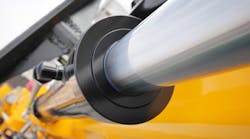At a Glance:
- In the near term, expect pneumatic devices to be embedded with electronics with diagnostic- and performance-monitoring capability.
- Onboarding of embedded controls in pneumatics will require devices to be self-learning and smart.
- Two high-level trends: the growth of Industrial Ethernet, and the growth and interoperability of wireless networks.
Manufacturers of motion and control components are seeing unprecedented expansion of macro technologies that drive opportunities and tensions.
At present, according to Rich McDonnell, pneumatic manufacturers are looking at integration capabilities that are built into their products and how these technologies will be able to work within real-time operating systems. The product manager for Smart and IoT Digital Products at Parker Hannifin, McDonnell’s deep engagement with the pneumatics and hydraulics industry for the past 12 years gives him a unique vantage as an analyzer tracking the industry’s emergent and ascending trends and technologies.
Indeed, McDonnell is keenly aware that bringing today’s legacy or brownfield systems up to date is an ongoing challenge, as companies go through technology step changes to bring them closer to real-time operating systems. “Being able to report from a sensing and controls standpoint is going to be a critical driver,” he said during a recent interview with Machine Design.
Machine Design: Give us a sense of the next generation of pneumatic devices. What is your focus and what are your plans in the near term?
Rich McDonnell: Sure. Short term is one to three years. In the short term, I believe you’ll see pneumatic devices, products and components introduced with some level of embedded electronics with diagnostic and performance monitoring capability. There is going to be an increasing amount of functionality brought down to the device level—not only expansion of advanced diagnostics but performance data, and potentially control brought down to the discrete, component level in pneumatic flow control or proportional control. Part of that will be to continue to build momentum in applications. As systems become smarter, control functionality will become more important.
MD: What are OEMs asking for? What are you hearing and how are you responding?
RM: Today, most OEMs are most interested in diagnostic capability. At the device level they’re asking for more of a diagnostic capability. The reason is primarily to be able to get them to some level of preventative maintenance programs. There’s still a lot of companies monitoring their equipment via clipboard. They’ve got a guy walking the floor and making checks on different types of settings and meters and gauges, and they’re charting that. The next step for them is to try to get rid of that, make that all digital and have real-time feedback on a steady basis to be able to say, “We’re operating within the desired parameters that we have for the equipment and the target parameters for production.”
MD: And beyond the immediate needs?
RM: Where I think most customers are leaning is towards control down at the lower-level devices. A technology trajectory of today would imply having control at the device level and for the operator to be able to command. And going from that diagnostic capability over to control is really where the future is. And where that is going to happen is—if you look at 5G—it’s going to be critical in manufacturing because it’s a true enabler. But I think the real cornerstone and the first enabler of this transition is the IO-Link protocol that will enable us to get to an IIoT environment within manufacturing.
From a wireless network standpoint, 5G is going to be yet another enabler to get us there. And there’s a whole series of those types of things evolving that are going to be able to bring a realization of IIoT across all different types of company sizes.
MD: How is Parker preparing for this transition?
RM: Equipment makers are now switching to machinery as a service. Part of that model is that OEMs will retain ownership of the equipment and the end-user basically pays for performance. If you think about the extensions of that, the end-user is going to have extremely high expectations of that equipment. What I mean by high expectations is high reliability. That reliability comes down to all of the components within that system and how they work together.
Critical to that is to have particular pieces of equipment talk to the end-users’ network to communicate performance of the equipment through data and visualization. End-users will want to be able to visualize upstream and downstream of that machine, and be able to diagnose components for problems. Today that can be the IO-Link and other Ethernet-based protocols. Switching to a machinery-as-a-service business model will require component manufacturers and pneumatic manufacturers to deliver much more intelligent systems. You’d be safe to say we’re building the required resources internally to be able to support that kind of transition and to support the end-user in making a leap to a smart integrated system within their enterprise.
MD: What do you consider to be relevant, growing trends over the longer haul?
RM: There are two key trends that I’m going to call the 250-thousand-foot trends. The first one of those is the Industrial Ethernet with Ethernet IP and PROFINET—and the growth of those two versus their competitors. And then I would say the other trend that’s key is wireless.
If you take look at Industrial Ethernet, with the Ethernet IP and PROFINET, the advent of OPC UA and IO-Link, then look at edge computing. You look at the analytics that are coming on and being developed: blockchain and AI, AR and VR. Below that you have a couple emergent things. One of those is, you know, single-pair Ethernet (SPE). And then you have OPC UA over TSN networking. And when you look at that trajectory, the gaining of Ethernet an IP and PROFINET over the other incumbent protocols that are out there, there’s clearly a direction that manufacturing—both discrete and processing—have chosen.
EtherCAT (Ethernet for Control Automation Technology) is still going to have a place. But as time-sensitive networking comes online and what they do for an end-user and potentially an OEM, those are all enablers to allow them to be able to monitor machines and control machines remotely and be able to bring a lot more value to an end-customer. Companies that provide machinery as a service first are going to have tremendous gains in the market. And those equipment makers that do that are going to want the latest and greatest capability, they're going to pay for that capability to be able to get the functionality that they need to be able to ensure that that machinery is running at its peak performance, 24/7.
On the wireless side: In the vernacular of the telecom companies, you’ve got 2G and 3G wireless being horizoned, and with 4G coming up behind that 5-6 years from now. And then there’s Wi-Fi 6 and 5G; I think there’s going to be a lot of interoperability between Wi-Fi 6 and 5G. I don’t think OEMs are going to select Wi-Fi 6 over 5G. I think there’s going to be a combination of those two.
Another important aspect is that private 5G networks are starting to catch momentum in Germany. Germany has already set aside a whole set of frequencies for private networks, and people are buying licenses—not only the automobile companies, but also other large companies like BASF Germany, to give an example. As the private 5G network strategy catches on, that’s going to make having a smart, intelligent flexible system that much more relevant and capable.
It’s a huge enabler because now you’re not fighting for bandwidth outside of that network with the public. Since you don’t have to worry about reliability, you can set up your security any way you want. All these other supporting technologies—from blockchain to AI to AR to VR—become a reality within that dedicated private network. From a machinery-as-a-service aspect, it’s desirable because now you can have your equipment makers tied right into the system. From there, visualization is going to be key as more companies not only want what their operator to visualize what’s happening within their equipment to enhance their productivity goals, but to be able to visualize that across the entire organization, from the operator to the C-suite.
MD: Let’s shift gears to energy efficiency. This is another area that’s on everyone’s radar. How is the demand for energy efficiency and improvement levels in uptime affecting the adaptation of pneumatics?
RM: One of the key things here is the economics. Looking at the economics of energy in North America, and the U.S. in particular, energy is still cheap in comparison to Europe and Asia. In Japan, energy costs are pretty high, especially as a result of what happened years ago at Fukushima. And, of course that relates back to energy.
My take is that most companies today are more concerned about looking at their carbon footprint to be socially responsible, rather than looking at it as an “energy” initiative. Maybe that’s just a fancier way to say energy initiatives; I’m not going to argue with that.
But when you look at the carbon footprint idea, and you look at the use of energy and how pneumatics can assist in that, this onboarding of embedded controls within devices is going to require those devices to be self-learning and require those devices to be smart from the standpoint of diagnostic and prognostic data, and be able to say, “In 10,000 cycles I need to be changed, because I’m not going to be performing at 93%, or better. So, swap me out between now and then.” That’s more of a preventative and predictive measure.
I mentioned earlier that flow control and proportional control is going to be a key element of energy conservation. Traditionally in pneumatics you would save energy—even before it was a buzzword—by dual pressure regulation in a circuit. Dual pressure regulation was a regulator on a particular station of a manifold. So, you would have on your work function (inside of your actuator) higher pressure and then you’d retract that with a lower pressure. That saves energy because you’re using less energy that return.
We’ll see a shift to more proportional flow control in functionality in the future. And because of that, those two technologies are going to become much more important, because now you can control that very discreetly and accurately via the embedded control. Then, when machines are idle or you want them to sleep for a period of time, you’ll be able to bring that net pressure down to just very minimal operating set up parameters to save energy.
Terminology:
IO-Link: A bi-directional, point-to-point serial communication protocol used to communicate with sensors and actuators.
PROFINET: An industrial Ethernet communications protocol that enables the exchange of data between controllers and devices.
Single Pair Ethernet: A cable configuration that uses one pair of wires to conduct data at speeds of up to 10Mbs. SPE provides reliable power (versus wireless) to sensors that are fixed to a physical location.


